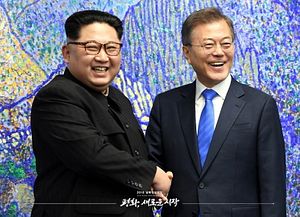Amidst the excitement and drama of a potential Kim-Trump summit in June, the substance and symbolism contained in the Panmunjom Declaration issued by the two Koreas generated comparatively little attention. This is unfortunate, as the accord is rich in consequences for both countries, for the region, and for the possible outcomes of the upcoming dialogue to follow between North Korea and the United States.
The Panmunjom Declaration assures the world that military action on the Korean peninsula will not happen anytime soon, and most likely never will. North Korean leader Kim Jong-un and South Korean President Moon Jae-in publicly declared their commitment to end the 60-year conflict, resolve their differences peacefully, and avoid even the risks of provocation. In practical terms, this means no more nuclear tests, missile launches, reconnaissance operations, or even escorted forays into disputed waters by North Korean crab fishermen (the casus belli of periodic hostilities along the Northern Limit Line in the West Sea). Both men are in full command of their respective governments, and neither they, nor in Moon’s case his likely liberal successor, are likely to renounce these very public commitments.
The historical frustration in seeking a permanent peace was attributable to each side’s stubborn ambition to reunify the peninsula on their own terms, but the unbearable costs in blood and treasure of doing so seems to have finally made Pyongyang and Seoul content to be masters of their own domains. Recent polling in South Korea indicates a majority of voters (and strong supermajorities of under 30 voters, a key part of Moon’s base) are not interested in full reunification, but rather a permanent reduction of the periodic tensions viewed as a drag on economic growth.
The Trump administration in the United States may continue to insist that the possibility of military action to relieve North Korea of its nuclear weapons remains on the table, a narrative which adds to the drama and importance of personal diplomacy, but don’t believe it. The two Koreas implicitly rebuked their respective superpower patrons in the Panmunjom Declaration, stating that the decision to seek war or peace would be made “on their own accord,” and that the choice has now been made. The U.S. military cannot undertake extensive, ground-based or even aerial combat operations required by an invasion of North Korea without the active participation and support of the ROK armed forces. A more limited strike, launched from aircraft aboard carriers or based overseas, is unlikely to succeed and may well trigger the massive retaliation against U.S. and allied targets that the strike would be intended to pre-empt. Bloodthirsty consumers of cable news may wish to change the channel; that part of the show is over.
But if we’re unlikely to see bombs bursting in air, can we at least hope for media-friendly photos of crumbling walls and streams of tear-stained refugees entering Seoul? For domestic and economic reasons, this scenario is even more improbable than war. With its aging population and slowing growth siphoned by a rising China, South Korea cannot afford the massive costs and concomitant shock of rapid, German-style unification; rather, a slow but steady China-Hong Kong annexation, as predicted by a 2009 Goldman Sachs study, is much more likely.
The Panmunjom Declaration’s approving reference to the Kaesong industrial complex is revealing; expect the two Koreas to create additional economic zones, perhaps on both sides of the 38th parallel, to leverage synergies among cheap North Korean labor, rich North Korean mineral resources (with an estimated present value at nearly 100 times current North Korean GDP), and South Korean technology and growth capital. The opportunities presented by phased integration and cross-border investment will be particularly welcome among South Korea’s befuddled industrial manufacturers, currently struggling to compete with China and facing the headwinds of rising labor costs at home. Border crossings by citizens of the two Koreas is likely to be restricted, with visas granted on a limited basis and subject to joint approval.
Beijing and Washington will no doubt be uneasy about the speed and complexion of Korean integration, but the costs to their own interests of restraining their respective historical allies should be of greater concern. Kim is no doubt keenly aware that every successful Asian tiger since World War II has benefited from striking a delicate balance between trading with neighboring China while courting friendly relations with the United States; his completed consolidation of power over the first five years of his rushed ascension to the throne, coupled with a growing sense of resentment at North Korea’s over dependence on China, may generate a new readiness to embrace American investment and open diplomatic relations with Washington. For North Korea, coming in from the cold requires an open door, and Washington should be ready to turn the knob now.
Patrick Monaghan is a former U.S. Navy intelligence officer, who served as indications and warning officer at the Combined Forces Command in Seoul from 1999-2000. He is now a practicing attorney, corporate board member and technology investor, residing in Seoul. Any opinions expressed herein are his own.
































